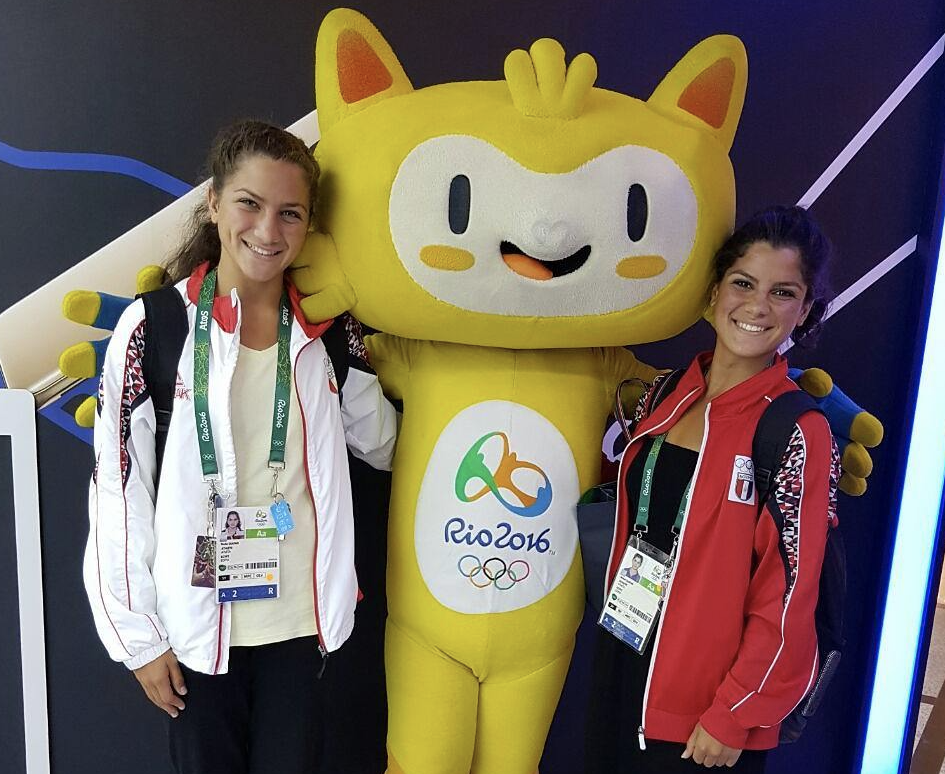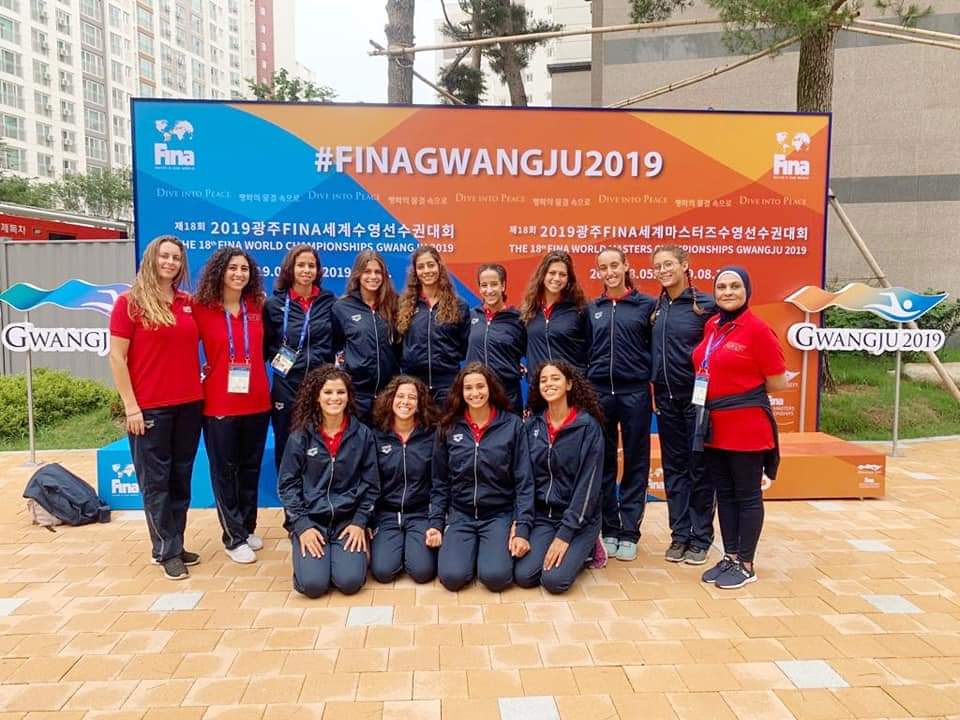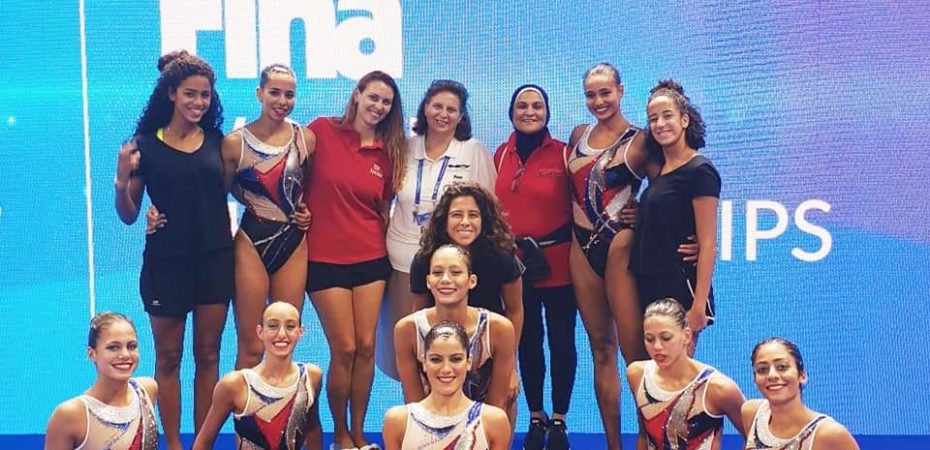Egypt has competed at every Olympic Games in artistic swimming as a team since 2008, and in the duet event since 2000. The Mediterranean nation has been the only African country at the Games ever since. Additionally, it is currently one of seven teams to already be qualified to the 2020 Olympic Games.
Nihal Saafan is currently one of the veterans on the senior national team. She competed at the 2016 Olympic Games, and has swum at every World Championships since 2013. As the team captain, the 24-year-old now guides her younger teammates on the road to Tokyo, all while balancing her professional workload.
Head coach Anastasiya Chepak took over the national team ahead of the 2017 season. The Ukraine native was already coaching in Egypt since 2011 at the Gezira Sporting club, and served as the national team assistant coach from 2014 to 2016.
With the guidance of Chepak and assistant coach Nour El Afandi, the Egyptian squad quickly showed progress in only two years. It improved by three points in technical team and nearly four in free team between the 2017 and 2019 FINA World Championships.
With only five months to go before the rescheduled 2020 Games, the young team wants to take it to the next level and finally reach the 80 points mark. Inside Synchro chatted with both Saafan and Chepak on their respective careers, the state of Egyptian artistic swimming, and what the national team has been working on since the summer of 2019.
IS: Egypt had just qualified a team and a duet to the Olympics at the 2019 World Championships. Obviously, everything changed when the pandemic hit a few months later. What has this past year been like for you?
Anastasiya Chepak: At the beginning, I was going crazy. I don’t like to stay home for more than two days, doing nothing. Then I understood I couldn’t do anything about it, and that I had to relax. We trained online during our lockdown, and we did this for four months. I didn’t like it very much. I like to see [the swimmers] and give them pointers or corrections in person. The pools finally reopened in July, but the national team wasn’t able to start getting together again until September. So really, we were not training as a team from March to September.
Nihal Saafan: Honestly, I cried when the Olympics were postponed. I was planning to finish my career after Tokyo 2020. When they pushed it another year, it was really hard. I had plans, life plans, work plans! I wanted to start my masters in architecture. So, my whole life got postponed too.
IS: Is everything back to normal now? What does a typical week of training look like?
AC: For now yes. I really hope we don’t close down again. The team trains from 5:00 p.m. to 9:30 p.m. mostly every day. Sometimes, they are late because they are in different schools all over Cairo, and in different systems of education. Usually by 6:00 p.m., we are all together. When they have holidays or before a big competition like Worlds, we train twice per day. But right now, our regular pool is under construction, so we have to go to different pools around the city. Bad timing (laughs)!
NS: I wake up at 6:00 a.m., go to work, and finish around 4:00 p.m. Then, I go to training. For now, I am working as an IGCSE teacher [International General Certificate of Secondary Education]. Schools finish in May, so I’ll be done teaching and free to focus on the Olympics. But I am actually an architect. Those working days are long and I’d miss training, so that’s on hold.
IS: Nihal, how did you get started in artistic swimming?
NS: I was just taking swimming lessons at first. One day, I was on the pool deck after practice, and there was this coach teaching girls things I didn’t understand. They were going under the water, raising their legs… I didn’t know what they were doing. That coach saw me and my twin sister [Nada] one day, and she talked to our dad to let us try out. My dad agreed. We found it really exciting, and we were doing stuff nobody could do. That was the fun part. We were four at that time. It was really cool to brag about doing synchronized swimming at school.
After that, I had swimming and synchro going in parallel for two or three years. Then I stopped swimming so I could put all my time in synchro. I made my first national team in 2011 for the COMEN Cup, then went to the Junior World Championships the year after. The Barcelona World Championships in 2013 were my favorites because they were my first. It was kind of a shock to be swimming with the seniors while I was just a junior, and to see face to face so many of my role models.
IS: Did you always know you wanted to go to the Olympics?
NS: Yes! Always. My sister and I thought about it a lot. We wanted to do it together, and maybe be the duet since we were twins. We didn’t get the chance to be the duet, but we did go together to the Olympics. It was a blast to live this dream together. It was out of this world.
IS: Tell me more about Rio.
NS: I cried during the opening ceremony! I couldn’t believe it was happening. After that, we had basically two weeks before the team events so it was a lot of intensive training. It was really tough actually, but it was worth it. Our goal was to pass Australia, and we did it. We were standing on the podium waiting for our scores. I am short-sighted, so I could not see anything. I kept asking, “What is our score?” over and over (laughs) No one was answering me because it wasn’t out yet. Then we all cried when it flashed. We had reached our goal, it was amazing.

IS: Anastasiya, you actually originally swam on Ukraine’s national team before becoming a coach. Can you talk about your own path?
AC: I started synchro when I was 10 years old. Well first, I was doing gymnastics, then I left the sport. After a while, I saw my coach Iryna Grebennikova on the street. She said I should try synchronized swimming, but I wouldn’t go to any competitions because I started too late (laughs). So I tried it, and I already had good basics with gymnastics. Eventually, she helped me get onto the national team of Ukraine. I was in it for six or seven years, until 2008.
After a while, I had a back injury so I didn’t want to push it. When I recovered, I decided it was time to move on. I was 23 years old. I also thought if I stayed in the sport longer, I would not be able to do anything else. You know… You feel like in a bubble, and you are a bit afraid to move on and do something else. I didn’t actually want to be a coach. I was studying to be a Ukrainian teacher and journalist. But again, my coach brought me back to the pool so I would help her. And here we are now!
IS: How did you find yourself in Egypt?
AC: At first, I coached the Thailand national team in 2010 for a few months. When I returned to Ukraine, I thought being a head coach was really hard and with a lot more responsibilities. So I said I would stay in Ukraine and just keep helping my coach. Maybe later on, I could coach the youth national team or something. Then Svetlana Saidova, the coach of Ukraine’s senior team, told me about a position in Switzerland that would last two years. But I couldn’t leave my country for two years, so I didn’t go. After a while, she told me about Egypt. This time, I said I would go for three months and if I didn’t like it, I would leave. That was nine years ago (laughs).
NS: She first came to my club, so she’s actually been my coach for that long!
IS: Is artistic swimming a popular sport in Egypt?
NS: No, not at all (laughs). We have it only in Cairo really, and not all clubs have a synchro section. It’s getting a bit better. There are more girls in the lower ages. But the older you get, the number of girls gets lower and lower.
IS: Right. The Egyptian team is always fairly young, and it seems there is a high turnover especially once the swimmers turn 18. Is it hard to retain the same group of athletes?
NS: Yes, I’m the only one left of our Rio team. I am the only one reliving this dream now (smiles). I have new girls with me. They are all younger, but they are all strong and work so hard. Actually, the same happened after London 2012. Only two or three from that team continued to the 2013 World Championships. The majority of them just quit. They just want to do something else, go out, work, or get married. So, it’s hard to really progress. We always have to start from scratch. It requires a lot of time and effort to select new girls to train together and for us to get used to each other. If we could have the same team training together for many years, it would be so much easier.
IS: Do you feel that cultural expectations play into that too? For example, have you ever faced criticism by doing artistic swimming, and all that comes with it, in a fairly conservative country?
NS: Of course. Before Rio, the media started talking about us, the Olympic team of synchronized swimming. They showed some of our videos on TV or on YouTube, and that was great. But we had very negative comments online. People insulted us, or said, “How can a dad let their daughter be like that?” What is, “Like that?” We are doing a sport. If you see tennis, they are wearing shorts. In gymnastics, they are wearing leotards. Why is synchronized swimming such a blackhole to everybody? So yes, we get negative comments all the time, but we don’t let them get into our minds. We love what we do. So, these people can just keep talking. No one will answer them.
IS: And obviously, your own families support you anyways.
NS: Yes, all of our families and our friends. That’s all that matters. And actually, the media here also supports us. They don’t cover our competitions all the time, but when it’s an important one like Rio, they do so perfectly. People got exposed to us and our sport, so that was great.
IS: Do you think that being represented in the Olympics has helped grow the sport in Egypt?
NS: Yes, a lot. You know, we somehow guarantee our place at the Olympics, but we work very hard to be representable. They pick the top teams from the continents, so we want to be up to these expectations and to that level. We don’t want anyone to say that we take it easy, or that Egypt just got there easily because there are not a lot of African teams. No. It’s not a joke for us. We take it very seriously, and we don’t want anyone to think otherwise. We want people to know that Egypt is progressing, and we are training hard to be as good as we can be.
IS: What else do you guys think is needed for artistic swimming to expand and for the team to continue improving?
AC: It needs more support from the government and towards education. In general, the girls who are in professional sports need to be better supported by the universities and schools. Our sport requires a lot of training time. We need that for a team to be stronger, more synchronized, and simply better. The schools should understand this and give the athletes more time. If it doesn’t happen, then it will always be hard.
IS: Is this the biggest difference in your opinion between Ukrainian and Egyptian artistic swimming?
AC: Yes, of course, the time. In Ukraine, we can spend eight to 10 hours per day training. The schools and universities support us and work with us. The first time I came to Egypt, I was going crazy. How come you might not come to training today because of school? Later, I realized the studies are very extensive here. For the girls, being a coach or being in sports doesn’t pay much. They have to study well and cannot miss exams or lessons. I have to adapt to that.
My girls on the national team are all very good. Nihal is an engineer, one of the swimmers in the Olympic duet will be a doctor… They all understand their responsibility, and they are trying to balance everything. Sometimes I feel sorry for them. Some days, we finish training late and they get home even later. It’s hard, but they manage so well. It’s just all passion. They love the sport, and they want to do it despite all the difficulties. And me being hard on them (laughs).
IS: Nihal, what has Anastasiya changed in your training or brought over from Ukraine?
NS: Her choreography style is very far away from what we did before. It’s so much better actually. The style of the training itself is completely different too. She gets us exposed to everything new, that’s a benefit for us. Now, we are focusing on a new technical routine. It’s very speedy. The music is also different, so that’s the exciting part.
AC: I’m trying now to focus mostly on the extension of their legs. I want the same legs as the Ukrainian and Russian teams (laughs). We are working a lot on that, synchronization and choreography also. Yes, we have a new technical team for the Olympics, and a new technical duet. We are excited to show them.

IS: What are some of the short-term and long-term goals for you or the team?
AC: 80 points. It’s doable, and we are trying our best. I also want to bring more Ukrainian style to the country. I’d like to invite my coach Iryna Grebennikova so she can come give us more tips and assist us. We don’t go to many meets so we don’t see much of our direct competition, or what other countries are doing. We need to be kept up to date with the sport all the time.
NS: Short term, to keep training and doing our best so we can achieve our goal in Tokyo. For the long term, I want to do my masters degree, and then maybe coaching on the side. My sister is a coach now, and she’s been helping with the junior national team. So, if I can coach with my sister, it would be such a dream.
ARTICLE BY CHRISTINA MARMET
If you’ve enjoyed our coverage, please consider donating to Inside Synchro! Any amount helps us run the site and cover costs to travel to meets during the season.


[…] had been a long-time goal of the Egyptians to finally reach the 80-points threshold. Upon seeing their scores, the athletes […]